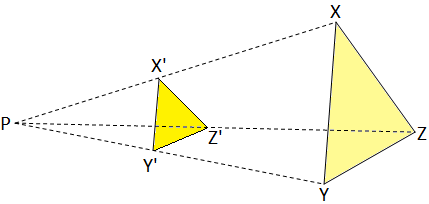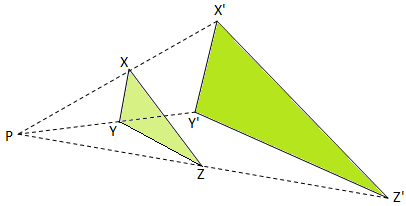Subscribe to our ▶️ YouTube channel 🔴 for the latest videos, updates, and tips.
Reduction Transformation
We will discuss here about the similarity on Reduction transformation.
In the figure given below ∆X’Y’Z’ is a reduced image of ∆XYZ.
The two triangles are similar. Here also the triangles are equiangular and \(\frac{X’Y’}{XY}\) = \(\frac{Y’Z’}{YZ}\) = \(\frac{Z’X’}{ZX}\) = k.
Here k is known as the reduction factor and P is known as the centre of reduction.
Therefore, in a size transformation, a given figure undergoes enlargement or reduction by a scale factor k, such that the resulting figure is similar to the original figure, i.e., the image retains the shape of the original object.
If ∆XYZ is transformed to ∆X’Y’Z’ by a scale factor k about the point P, we get \(\frac{PX’}{PX}\) = \(\frac{PY’}{PY}\) = \(\frac{PZ’}{PZ}\) = k.
2. A rectangle PQRS has been reduced to a rectangle P’ Q’ R’ S’ and their areas are 192 cm\(^{2}\) and 12 cm\(^{2}\) respectively. If Q’ R’ is 3 cm, then find QR.
Solution:
Let \(\frac{area of P’ Q’ R’ S’}{area of PQRS}\) = k\(^{2}\)
Therefore, \(\frac{12 cm\(^{2}\)}{192 cm\(^{2}\)}\) = k\(^{2}\)
⟹ \(\frac{1}{16}\) k\(^{2}\)
⟹ k = \(\frac{1}{4}\)
Now, \(\frac{Q’ R’}{QR}\) = k
⟹ \(\frac{3 cm}{QR}\) = \(\frac{1}{4}\)
⟹ QR = 12 cm
From Reduction Transformation to HOME PAGE
Didn't find what you were looking for? Or want to know more information about Math Only Math. Use this Google Search to find what you need.




New! Comments
Have your say about what you just read! Leave me a comment in the box below. Ask a Question or Answer a Question.